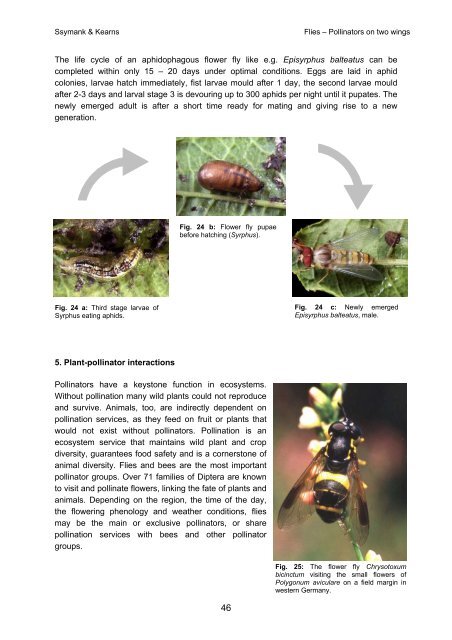Caring for Pollinators - Bundesamt für Naturschutz
Caring for Pollinators - Bundesamt für Naturschutz
Caring for Pollinators - Bundesamt für Naturschutz
Create successful ePaper yourself
Turn your PDF publications into a flip-book with our unique Google optimized e-Paper software.
Ssymank & Kearns Flies – <strong>Pollinators</strong> on two wings<br />
The life cycle of an aphidophagous flower fly like e.g. Episyrphus balteatus can be<br />
completed within only 15 – 20 days under optimal conditions. Eggs are laid in aphid<br />
colonies,<br />
larvae hatch immediately, fist larvae mould after 1 day, the second larvae mould<br />
after 2-3 days and larval stage 3 is devouring up to 300 aphids per night until it pupates. The<br />
newly emerged adult is after a short time ready <strong>for</strong> mating and giving rise to a new<br />
generation.<br />
Fig. 24 a: Third stage larvae of<br />
Syrphus eating aphids.<br />
5. Plant-pollinator interactions<br />
Fig. 24 b: Flower fly pupae<br />
be<strong>for</strong>e hatching (Syrphus).<br />
<strong>Pollinators</strong><br />
have a keystone function in ecosystems.<br />
Without pollination many wild plants could not reproduce<br />
and survive. Animals, too, are indirectly<br />
dependent on<br />
pollination services, as they feed on fruit or plants that<br />
would not exist without pollinators. Pollination is an<br />
ecosystem service that maintains wild plant and crop<br />
diversity, guarantees food safety and is a cornerstone of<br />
animal diversity. Flies and bees are the most important<br />
pollinator groups. Over 71 families of Diptera are known<br />
to visit and pollinate flowers, linking the fate of plants and<br />
animals. Depending on the region, the time of the day,<br />
the flowering phenology and weather conditions, flies<br />
may be the main or exclusive pollinators, or share<br />
pollination services with bees and other pollinator<br />
groups.<br />
46<br />
Fig. 24 c: Newly emerged<br />
Episyrphus balteatus, male.<br />
Fig. 25: The flower fly Chrysotoxum<br />
bicinctum visiting the small flowers of<br />
Polygonum aviculare on a field margin in<br />
western Germany.

















